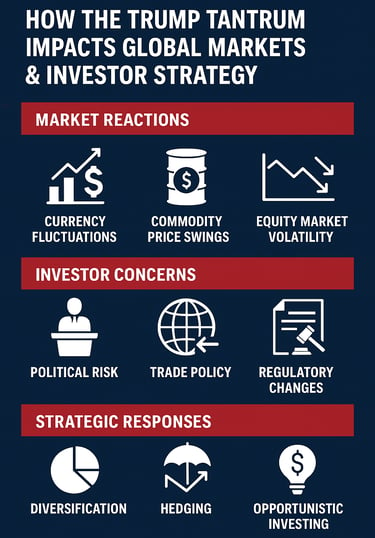Why Investors Can’t Ignore the “Trump Tantrum”: Market Volatility Meets Political Power
Understand why investors must pay attention to the “Trump Tantrum” — the market’s emotional reaction to policy statements, trade moves, and political shifts. Learn how to turn political volatility into investment opportunity.
RAVINDRA PRAJAPATI (EDUCATIONAL BLOG)
10/11/20255 min read


Introduction: The Political-Market Nexus
In modern financial markets, politics has become an integral part of price discovery. The global economy is not just shaped by monetary policy or corporate performance but by the unpredictable rhythm of political personalities and decisions. Among these influences, one phenomenon that continues to capture investor attention is what analysts term the “Trump Tantrum.”
The phrase originated during Donald Trump’s presidency, referring to sudden market reactions—often violent and sentiment-driven—to his policy announcements, social media posts, and public statements. However, the idea extends beyond one leader; it represents a new era of politically triggered volatility, where investor psychology, media amplification, and policy uncertainty collide.
In this analysis, we explore why every serious investor must focus on the Trump Tantrum, not from a partisan lens but as a market behavior case study in how power, perception, and unpredictability move money.
1. Defining the “Trump Tantrum”
The term "Trump Tantrum" first surfaced in 2016–2017, describing how Donald Trump’s unexpected statements or policy decisions led to rapid market movements. For instance, when Trump hinted at trade restrictions against China or withdrew from global treaties, markets would react within minutes — currencies fluctuated, commodities spiked, and equities corrected.
This volatility mirrored earlier episodes like the “Taper Tantrum” of 2013, when U.S. Federal Reserve signals triggered global bond sell-offs. But the Trump version was different — it wasn’t triggered by central bank policy but by political rhetoric and policy shocks.
Over time, the “Trump Tantrum” became shorthand for any political or populist intervention that disrupts normal market functioning. Investors learned a crucial truth: Markets don’t just respond to economics; they respond to emotion and uncertainty.
2. The Core Drivers Behind the Tantrum
Several underlying forces make the Trump Tantrum phenomenon worth studying:
a. Policy Volatility
Trump’s leadership style emphasized unpredictability. From renegotiating trade deals to reshaping energy policy, his administration signaled that status quo was no longer guaranteed. For investors, that meant re-pricing risk on a near-daily basis.
b. Information Speed
Social media amplified every statement instantly. A tweet could wipe billions off market capitalization before analysts could interpret it. This real-time reaction loop created new kinds of short-term volatility, testing even algorithmic trading systems.
c. Market Psychology
Markets are built on confidence and expectation. When leadership signals were inconsistent, investor confidence swung sharply, increasing correlation across asset classes. The market began reacting more to tone and personality than to balance sheets or earnings data.
d. Global Interdependence
Trump’s America-first approach triggered global spillovers. Trade tensions affected Asian manufacturing indices, emerging market currencies, and commodity exports. Investors could no longer separate U.S. political risk from global portfolio exposure.
3. Why Investors Must Pay Attention
For professional investors, ignoring the Trump Tantrum is equivalent to ignoring a risk variable that directly influences returns. Here’s why:
a. Political Events Are Now Market Catalysts
In traditional finance, politics was considered “noise.” Today, it’s a primary signal. Policy announcements determine interest rate expectations, trade flows, and inflation outlooks — all key inputs in asset valuation models.
b. Volatility Equals Opportunity
Institutional investors understand that volatility, while risky, also creates mispricing opportunities. During tantrum events, quality assets often sell off irrationally. Those with liquidity and discipline can enter at discounted valuations.
c. Correlation Breakdowns
Tantrum episodes reveal where correlation models fail. Assets that were previously uncorrelated may suddenly move together due to sentiment contagion. Tracking these moments helps investors improve diversification strategy.
d. Sentiment as a Leading Indicator
In the digital age, sentiment often precedes fundamentals. By monitoring the political narrative and social sentiment during tantrum events, investors can anticipate capital flow shifts before they appear in financial data.
4. Case Studies: How the Trump Tantrum Moved Markets
a. The Trade War Shock (2018–2019)
When Trump announced tariffs on Chinese imports, markets across Asia dropped overnight. The S&P 500 fell 6% in a week, while the Chinese yuan depreciated to a record low. Yet, savvy investors who analyzed supply chain resilience identified technology and logistics firms that later outperformed.
b. The Federal Reserve Pressure (2018)
Trump’s public criticism of the Federal Reserve created uncertainty around central bank independence. The market perceived potential policy interference, causing bond yields to rise and equity risk premiums to widen. Institutional investors started pricing political pressure into their macro models.
c. Oil and Energy Markets
When Trump imposed sanctions on Iran or tweeted about OPEC decisions, oil futures responded within hours. The link between geopolitics and commodities became a textbook example of how executive influence can reshape short-term supply-demand expectations.
d. The Post-Election Rally (2016)
Immediately after Trump’s 2016 victory, markets unexpectedly rallied — contrary to many forecasts. Investors initially feared uncertainty but quickly priced in tax cuts and deregulation optimism, leading to a 20% surge in the Dow within months.
Each of these episodes reinforced a key insight: political personality and policy direction are now embedded in market volatility models.
5. Investor Psychology and Behavioral Finance
The Trump Tantrum also provides a unique laboratory for studying behavioral finance. Here’s what it reveals about investor behavior:
Overreaction Bias: Markets often price in extreme scenarios immediately after political news.
Confirmation Bias: Investors interpret events through ideological filters rather than data.
Herding Effect: Social media amplifies fear and greed, leading to synchronized global movements.
Recency Bias: Short-term events dominate long-term judgment, even among seasoned traders.
For portfolio managers, recognizing these biases is crucial. Those who stay data-driven amid emotional markets can exploit sentiment mispricing — a skill that defines elite investors.
6. Strategic Implications for Investors
a. Risk Management
Political volatility must now be treated as a distinct risk category, akin to credit or liquidity risk.
Investors should:
Stress-test portfolios for policy shocks.
Include event-driven scenarios in valuation models.
Adjust stop-loss thresholds during high-volatility phases.
b. Asset Allocation Adjustments
Periods of tantrum-driven uncertainty often reward defensive assets like gold, bonds, and dividend-paying stocks. Meanwhile, sectors exposed to policy swings — such as energy, trade, and defense — demand active monitoring.
c. Global Diversification
Investors concentrated in one geography face amplified political risk. Global diversification, especially across asynchronous economies, cushions portfolios against country-specific tantrums.
d. Tactical Positioning
Short-term traders can leverage volatility spikes through options or volatility ETFs, provided they understand the underlying macro context. Long-term investors can accumulate high-quality stocks when markets overreact.
7. The Trump Tantrum and Emerging Markets
Emerging economies are often the first to feel the ripple effects of U.S. political shocks.
For instance:
U.S.-China tensions reduced Asian export demand.
Dollar strength led to capital outflows from India, Brazil, and Indonesia.
Commodity-dependent economies saw sharp terms-of-trade fluctuations.
Thus, emerging market investors must track not only local fundamentals but also U.S. political narratives. In globalized finance, a tweet in Washington can move a market in Mumbai.
Conclusion: Volatility as the New Normal
The “Trump Tantrum” symbolizes more than one politician’s influence — it defines an era of hyper-connected markets, where information velocity and human psychology merge.
For investors, the lesson is clear:
Political risk is market risk. And market risk is opportunity in disguise.
Ignoring tantrum-driven volatility means missing out on valuable insight into how global capital behaves under stress.
By studying and adapting to it, investors gain not just protection — but profit.
Key Takeaways for Investors:
Treat political volatility as a core investment factor.
Use sentiment analysis and event-tracking tools.
Diversify geographically and across asset classes.
Maintain discipline — avoid emotional trades.
View market tantrums as data, not drama.
Key Tags:
#TrumpTantrum #MarketVolatility #PoliticalRisk #InvestorStrategy #BehavioralFinance #GlobalMarkets #InvestmentAnalysis
RAVINDRA PRAJAPATI, Not a sebi registered
FOLLOW Us
ravindra.prajapati1122@gmail.com
+91 9795187745
© 2025. PiPiFinTech All rights reserved.
Contact Us
ABOUT Us
Our mission is to empower you to maximize every single penny and best solution for wealth generation and management for every mature age group.
Product TOPICS
Digital E-Wealth Platform
Mutual Funds
Education Planning
Insurance
FD and Bonds
Retirement Planning
Wealth Creation
(Disclaimers : Mutual Fund investments are subject to market risks, please read scheme related documents carefully.)
